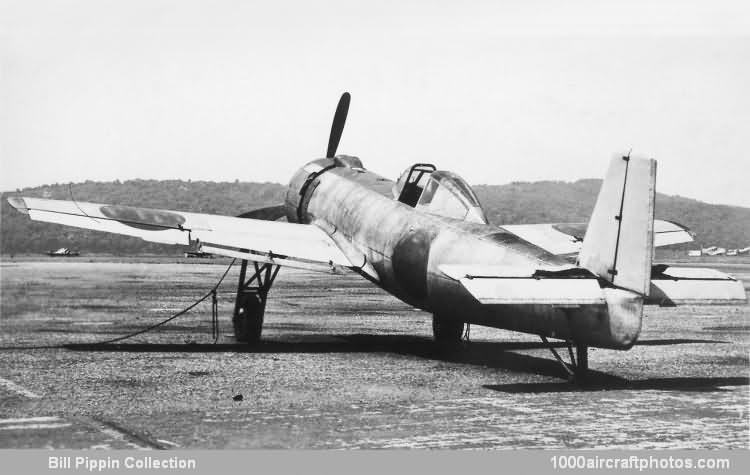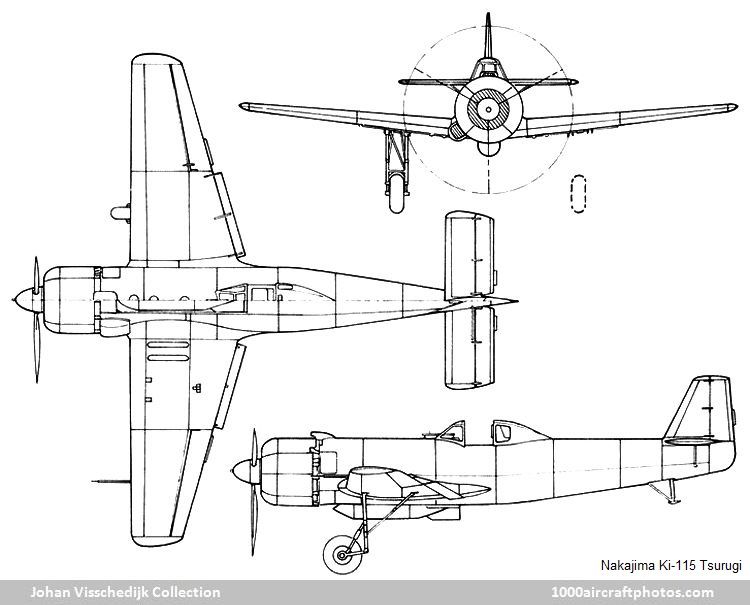03/31/2013. Remarks by Johan Visschedijk: "Anticipating that the varied collection of obsolescent combat aircraft and trainers set aside for taiatari suicide attacks in the event of an invasion of the homeland would be insufficient to rout the Allied forces, on January 20, 1945, the Imperial Japanese Army Air Force instructed Nakajima Hikoki K.K. (Nakajima Aeroplane Co. Ltd.) to build a specially designed single-seat suicide attack aircraft.
The aircraft was to be easy to build, maintain and fly, and provision had to be made in its design for carrying a single bomb. Power was to be supplied by any air-cooled radial engine with a rating of 800 hp to 1,300 hp, driving a fixed-pitch three-blade metal propeller. Maximum speed was specified at 211 mph (340 kmh) with the landing gear in position and 320 mph (515 kmh) after jettisoning.
Assisted by personnel of Mitaka Kenkyujo (Mitaka Research Institute) at Mitaka and Ota Seisakusho K.K. (Ota Manufacturing Co. Ltd.) at Ota, Engineer Aori Kunihiro designed the Ki-115a Suicide Attacker Tsurugi (Sabre). Planned to be built by semi-skilled labor, the aircraft was the essence of simplicity. The all-metal wings had stressed-skin outer surfaces, the fuselage had a steel structure with tin engine cowling and steel panels on the front- and center sections, and the fabric covered tail surfaces had a wooden structure.
A variety of surplus engines could be used and were to be attached to the fuselage by four bolts, but all aircraft built were fitted with the 1,150 hp Nakajima 23 fourteen-cylinder air-cooled radial. The pilot sat in an open cockpit above the wing trailing edges and provision was made for a single bomb of up to 1,764 lb (800 kg) attached to a semi-recessed crutch under the fuselage center section. The non-retractable legs of the main landing gear were to be jettisoned after take off for a suicide mission.
The first prototype was completed in March 1945 and flight tests began immediately. As could be expected from such a crash program, the results were disappointing and the aircraft suffered from extremely poor handling characteristics on the ground. The crudity of the landing gear, built of welded steel piping and lacking shock absorbers, combined with poor forward vision from the cockpit, rendered the aircraft difficult to handle, and modifications were required before handing the aircraft to pilots with limited experience.
By the time basic flight tests were completed in June 1945, a redesigned landing gear with shock absorbers was fitted and auxiliary flaps attached to the inboard wing trailing edges were added. Provision was made on the 104 production aircraft for two solid-fuel rockets under each wing to boost the aircraft's speed in its final dive.
A total of 105 Ki-115a's were built between March and August 1945, the prototype by Mitaka, 22 by Nakajima at Iwate, and 82 by Nakajima at Ota. None of these aircraft became operational, but two were delivered to Showa Hikoki K.K. (Showa Aeroplane Co. Ltd.) at Tokyo, which had been selected as the prime contractor for the proposed Toka Wistaria (Suicide Attacker), the Imperial Japanese Navy Air Service version of the Ki-115 which was to be powered by various reconditioned surplus engines.
The Ki-1I5b was a projected version with wooden wings of increased area fitted with flaps and in which the pilot's seat was moved forward. None had been completed when Japan surrendered, and the Ki-230, a development of the basic design, remained on the drawing boards.

